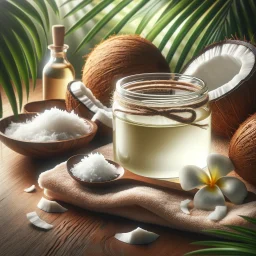
Grapeseed Oil for Massage: Why It’s Popular and How to Use It
1. Introduction: What is Grapeseed Oil?
Grapeseed oil, as the name suggests, is derived from the seeds of grapes—most commonly those left over from the winemaking process. This lightweight oil is extracted using either cold-pressing or solvent extraction methods, although cold-pressed grapeseed oil is considered superior due to its preservation of nutrients and absence of chemical residues.
Why is Grapeseed Oil Popular for Massage?
Lightweight and Non-Greasy Texture: Unlike some thicker oils, grapeseed oil is known for its silky texture that is easily absorbed into the skin without leaving a greasy residue. This makes it perfect for massage therapy, as it allows smooth hand movement while minimizing that “heavy” feeling.
Suitable for All Skin Types: Grapeseed oil is non-comedogenic, meaning it won’t clog pores. This makes it suitable for people with sensitive, oily, or acne-prone skin, providing hydration without causing breakouts.
Nutrient-Rich Composition: Packed with antioxidants, vitamins, and essential fatty acids, grapeseed oil helps nourish and protect the skin, making it not only an excellent carrier oil but also beneficial in its own right.
2. Nutritional Composition of Grapeseed Oil
Understanding the nutritional profile of grapeseed oil reveals why it is such a fantastic choice for massage and skincare. Grapeseed oil is rich in several vital nutrients that promote skin health:
Key Nutrients in Grapeseed Oil:
Linoleic Acid (Omega-6 Fatty Acid): Comprising over 70% of grapeseed oil, linoleic acid is an essential fatty acid that helps maintain the skin’s barrier function, preventing moisture loss and enhancing hydration. It also has anti-inflammatory properties that can soothe irritated skin.
Vitamin E (Tocopherol): A powerful antioxidant that helps protect the skin from oxidative stress caused by free radicals. Vitamin E in grapeseed oil can help improve skin elasticity, reduce the appearance of scars, and provide a youthful glow.
Phytosterols: Plant compounds that help repair and reinforce the skin’s natural barrier. Phytosterols also possess anti-inflammatory properties that can help reduce skin redness and irritation.
Polyphenols: These antioxidants have anti-aging and anti-inflammatory properties, helping to protect the skin from environmental damage and reducing the appearance of wrinkles and fine lines.
Benefits of These Nutrients for Massage:
The high linoleic acid content makes grapeseed oil excellent for moisturizing and softening the skin, while the antioxidants like vitamin E protect the skin during the massage.
These nutrients help in repairing damaged skin and maintaining its natural hydration balance, making it suitable for prolonged massage sessions and daily use.
3. Benefits of Using Grapeseed Oil for Massage
Grapeseed oil is lauded for its numerous skin benefits, making it a favorite among massage therapists and skincare enthusiasts. Here’s a breakdown of the most significant benefits:
1. Deep Hydration and Skin Softening
Grapeseed oil’s light texture allows it to penetrate the skin quickly, providing deep hydration without clogging pores. It helps to soften and smooth the skin, making it an excellent option for those with dry or rough skin.
2. Anti-Inflammatory and Antioxidant Properties
The high content of antioxidants, such as vitamin E and polyphenols, helps to protect the skin from environmental damage and reduces inflammation. This makes grapeseed oil particularly beneficial for massages aimed at soothing muscle pain or reducing inflammation in sensitive areas.
3. Improves Skin Tone and Reduces Scarring
Regular use of grapeseed oil during massage can help improve skin tone and texture due to its regenerative properties. The vitamin E in grapeseed oil aids in reducing the appearance of scars and stretch marks by promoting skin repair and regeneration.
4. Non-Comedogenic and Suitable for Oily or Acne-Prone Skin
Grapeseed oil is non-comedogenic, meaning it doesn’t clog pores. This makes it suitable for people with oily or acne-prone skin who need hydration without risking breakouts. It balances skin’s natural oils and helps in controlling acne formation.
5. Enhances Blood Circulation
The smooth glide provided by grapeseed oil makes it an excellent choice for massage therapy, facilitating better blood flow and circulation. Improved circulation helps in the relaxation of tense muscles and provides a sense of overall well-being.
4. Why Grapeseed Oil is a Popular Choice Among Massage Therapists
Grapeseed oil has gained a strong reputation among massage therapists for a variety of reasons. Its versatility, lightweight nature, and range of skin benefits make it an ideal choice for various types of massage and skin treatments. Here’s why it stands out:
1. Lightweight and Easily Absorbed
Grapeseed oil is known for its light, silky texture that absorbs quickly into the skin. This means it provides enough glide for massage without leaving an overly greasy residue, allowing therapists to maintain a good grip without constantly reapplying the oil.
2. Affordable and Widely Available
Compared to some other massage oils, such as jojoba or argan oil, grapeseed oil is relatively affordable while still offering high-quality benefits. Its cost-effectiveness makes it a preferred choice for professional massage therapists who need to use large quantities of oil regularly.
3. Suitable for Sensitive Skin and Allergies
Grapeseed oil is hypoallergenic and safe for most skin types, including sensitive and allergy-prone skin. Its gentle nature means it rarely causes allergic reactions, making it a safe bet for massage therapists working with a diverse clientele.
4. Odorless Base for Essential Oil Blends
Being virtually odorless, grapeseed oil serves as an excellent carrier oil for blending with essential oils. This allows massage therapists to customize treatments based on the needs of their clients, whether they’re looking for relaxation, pain relief, or rejuvenation.
5. High in Antioxidants and Anti-Inflammatory Properties
The antioxidants in grapeseed oil, such as vitamin E, help protect the skin from oxidative stress and environmental damage. Its anti-inflammatory properties make it a great choice for massages aimed at reducing muscle soreness and inflammation.
5. How to Use Grapeseed Oil for Different Types of Massages
Grapeseed oil’s versatility makes it suitable for a wide range of massage techniques. Whether it’s a relaxing Swedish massage or a deep tissue therapy session, grapeseed oil can be adapted to enhance the experience. Here’s how to use it effectively:
1. Swedish Massage
For a Swedish massage, grapeseed oil provides the perfect glide without feeling heavy. Warm the oil slightly in your hands before applying it to the skin. Use long, sweeping strokes to help improve circulation and relieve tension. The lightweight nature of grapeseed oil ensures a smooth, flowing movement throughout the massage.
2. Deep Tissue Massage
When using grapeseed oil for deep tissue massage, a little goes a long way. Its medium absorbency rate allows it to offer enough grip for the deeper strokes required in this technique without the need for frequent reapplication. Mixing it with a small amount of heavier oil, like avocado oil, can provide extra lubrication while still allowing therapists to reach the deeper muscle layers.
3. Aromatherapy Massage
Grapeseed oil is an excellent carrier oil for aromatherapy massages. Blend it with essential oils like lavender, eucalyptus, or peppermint to enhance relaxation or provide specific therapeutic benefits. The oil’s odorless quality allows the essential oils to stand out without interference, providing a pleasant and customized massage experience.
4. Hot Stone Massage
For hot stone massage, grapeseed oil’s high smoke point and non-greasy feel make it an ideal choice. Apply a thin layer of grapeseed oil on the skin before placing the hot stones. The oil helps the stones glide smoothly while protecting the skin from excessive heat, creating a calming and effective therapy session.
5. Prenatal Massage
Due to its gentle and non-comedogenic properties, grapeseed oil is a safe option for prenatal massages. It helps soothe and moisturize the skin without causing breakouts or irritation, which is particularly important for expecting mothers with sensitive skin.
6. Blending Grapeseed Oil with Essential Oils: Top Recipes
Grapeseed oil is an excellent carrier oil, blending well with various essential oils to create powerful massage oils tailored to specific needs. Here are some top blends and recipes to try:
1. Relaxation Blend
Recipe: Combine 2 tablespoons of grapeseed oil with 5 drops of lavender essential oil, 3 drops of chamomile essential oil, and 2 drops of sandalwood essential oil.
Benefits: This blend is perfect for calming the mind and body. Lavender and chamomile provide soothing effects, while sandalwood adds a grounding element to the massage, making it ideal for stress relief.
2. Pain Relief Blend
Recipe: Mix 2 tablespoons of grapeseed oil with 4 drops of peppermint essential oil, 3 drops of eucalyptus essential oil, and 3 drops of marjoram essential oil.
Benefits: The combination of peppermint and eucalyptus creates a cooling sensation that helps reduce muscle pain and inflammation. Marjoram adds a relaxing touch, making this blend suitable for deep tissue or sports massages.
3. Energizing Blend
Recipe: Blend 2 tablespoons of grapeseed oil with 5 drops of grapefruit essential oil, 3 drops of rosemary essential oil, and 2 drops of juniper berry essential oil.
Benefits: This uplifting blend helps boost energy and mental clarity. Grapefruit and rosemary invigorate the senses, while juniper berry supports detoxification and improves circulation.
4. Skin Nourishment Blend
Recipe: Combine 2 tablespoons of grapeseed oil with 4 drops of rose essential oil, 3 drops of geranium essential oil, and 2 drops of frankincense essential oil.
Benefits: This blend is perfect for facial massages or skin treatments. Rose and geranium oils provide deep hydration and balance, while frankincense helps in cell regeneration and reducing the appearance of scars.
7. How to Choose High-Quality Grapeseed Oil for Massage
Choosing the right grapeseed oil is crucial to ensure you’re getting the maximum benefits for massage and skincare. With numerous options available in the market, it’s important to understand what to look for in a high-quality product. Here’s a guide to help you make an informed choice:
1. Cold-Pressed vs. Refined
Cold-Pressed Grapeseed Oil: This type of oil is extracted without the use of heat, which helps retain most of its natural nutrients, antioxidants, and beneficial compounds. Cold-pressed grapeseed oil is generally greener in color and has a subtle, natural aroma. For massages and skincare, cold-pressed is the preferred choice due to its purity and higher nutrient content.
Refined Grapeseed Oil: This oil undergoes processing with heat and sometimes chemicals, which can strip it of some nutrients but increase its shelf life. It is often clearer in color and has a neutral scent. While refined oil is less expensive, it is not as beneficial for therapeutic use as cold-pressed varieties.
2. Organic Certification
Choosing an organic grapeseed oil ensures that the oil is free from pesticides, synthetic fertilizers, and harmful chemicals. Organic certifications from reputable organizations like USDA or ECOCERT add an extra layer of assurance that the oil is pure and safe for use on all skin types, especially sensitive skin.
3. Packaging Matters
Grapeseed oil is rich in antioxidants, but it is also sensitive to light and air exposure, which can cause it to oxidize and lose its beneficial properties. Look for oils packaged in dark glass bottles or opaque containers to protect the oil from light and maintain its freshness and potency.
4. Read the Ingredients
Always check the ingredient list. A high-quality grapeseed oil should have only one ingredient: 100% pure Vitis vinifera (grapeseed) oil. Avoid products with additives, preservatives, or synthetic fragrances, as these can irritate the skin and dilute the benefits of the oil.
5. Check for Certifications and Testing
Look for brands that offer third-party testing and certifications for purity and quality. This ensures that the grapeseed oil is free from contaminants and is of high quality, which is essential for therapeutic and massage purposes.
8. Storing and Caring for Your Grapeseed Oil: Tips for Prolonging Freshness
Proper storage of grapeseed oil is essential to maintain its quality, potency, and effectiveness. Improper storage can lead to oxidation, rancidity, and loss of beneficial properties. Here are some practical tips on how to store and care for your grapeseed oil to prolong its freshness:
1. Store in a Cool, Dark Place
Grapeseed oil should be stored in a cool, dark place away from direct sunlight and heat sources. Exposure to heat and light can cause the oil to oxidize more quickly, leading to a rancid smell and reduced effectiveness. A pantry or a cabinet away from the stove is an ideal spot.
2. Use Dark Glass Bottles
If you purchase grapeseed oil in large quantities, consider transferring small amounts to a dark glass bottle for daily use. This minimizes the exposure of the bulk oil to air and light, helping maintain its freshness for a longer period.
3. Keep the Bottle Sealed Tightly
Make sure to always close the bottle tightly after each use to prevent air from entering. Air exposure can lead to oxidation, which reduces the oil’s shelf life and effectiveness. A tightly sealed cap is essential for preserving the oil’s quality.
4. Refrigeration: Yes or No?
While refrigeration is not necessary, it can help prolong the shelf life of grapeseed oil, especially if you live in a warm climate. Refrigerated grapeseed oil may turn slightly cloudy, but this does not affect its quality or benefits. Just allow it to return to room temperature before use to restore its clarity.
5. Regularly Check for Rancidity
Grapeseed oil typically has a shelf life of about 6 to 12 months. Regularly check for signs of rancidity, such as a sour or bitter smell or an off-taste. If the oil smells unpleasant or has changed in color, it’s time to replace it.
6. Avoid Contamination
Avoid dipping your fingers directly into the oil or using unclean utensils to scoop out the oil, as this can introduce bacteria and contaminants. Use a clean dropper or spoon to pour out the oil to maintain its purity and safety.
Must read!
Grapeseed oil is ideal for softening and nourishing skin, and I often use it in my Magic Massage to enhance the sensory experience. Check out my full Services and Price Overview to see other offerings. You can also book your session here if you’re ready to experience it.









